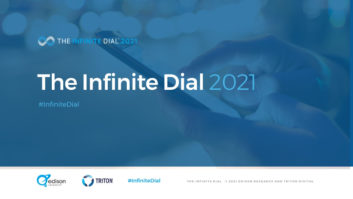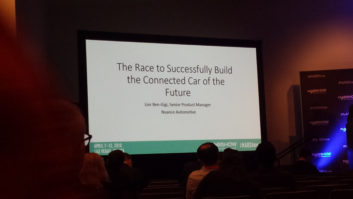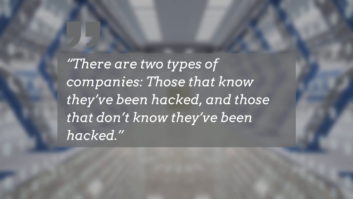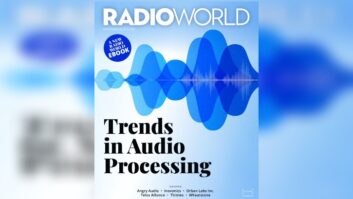With an NAB Show ahead and a CES show behind, this seems like an appropriate time to ask about defining trends that will affect the radio industry this year.

Many, if not all, will have been on your radar for some time, but in 2018, it’s clear these technologies are less “fad” and more “evolution.”
THE CAR AND CITY OF THE FUTURE
NAB Pilot joined the Genivi Alliance in Q3 2017. The alliance consists of approximately 140 companies developing open software for in-vehicle infotainment and the connected car.
“Our goal is to advance the in-vehicle radio experience for consumers by engaging with the automotive industry to capitalize on new and emerging technologies,” said NAB Chief Technology Officer Sam Matheny.
He said the collaboration offers a “unique opportunity to liaise” with representatives from across the connected car industry.
For Genivi’s part, Executive Director Steve Crumb said, “Radio is the genesis of in-vehicle infotainment, and collaborating with NAB provides the opportunity to further advance radio technology and deliver other content for incorporation into the in-vehicle experience of the future.”
Learn more about Genivi in this article: https://tinyurl.com/yb84qnsj.
NextRadio is getting in on the connected car action by partnering with Abalta Technologies to link the hybrid radio app to in-vehicle infotainment systems powered by Abalta’s WebLink software platform.

According to the company, the first iteration of NextRadio for WebLink is available in some aftermarket head units from JVC and Kenwood and slated to ship this year.
iHeartRadio is now available to more than a million 4G-LTE connected Chevrolet, Buick, GMC and Cadillac owners on their dashboard. The app will continue to be pre-installed on new GM vehicles throughout 2018.
Also, iHeartMedia says Ford will be the first OEM to fully integrate with the iHeartRadio app through an upgrade to the Ford Sync AppLink integration.
Media company Gracenote is attempting to address AppleCarPlay’s radio “problem” with a “hybrid” radio app of its own. According to its website, the aim is to offer “one interface for every musical source,” and that includes local AM/FM radio.
The streaming platform integration means listeners can hear a song on the radio and then transition to a playlist on their favorite subscription service based on that tune.
Xperi recently announced a new feature for its DTS Connected Radio platform: music recognition technology, enabled by ACRCloud. The company’s own version of a hybrid radio system combines over-the-air analog/digital AM/FM radio with IP-delivered content is expected to launch later this year.
Xperi General Manager for Automotive Jeff Jury said the addition of music recognition technology is part of the company’s quest to “ensure that the best broadcast radio experience is occurring in the vehicle.”
And music isn’t all that the connected car is learning to recognize Ñ according to Xperi’s website, technology from “Invensas and FotoNation are pushing the limits on in cabin recognition and driver monitoring.”
Autonomous cars are not without controversy, and the trend is inching closer to reality as manufacturers and ride share companies test out how the concept could work in the real world.
CES 2018 featured a Self-Driving Marketplace that showcased technology from exhibitors including Aptiv, Arbe Robotics, Arvato Distribution GmbH, Autoliv, BYTON, Clarion Corp. of America, IAV Automotive Engineering, Navya, Renesas Electronics America, Torc Robotics, TRW Automotive Electronics & Components, Valeo and ZF Friedrichshafen AG.

Ford Motor Co. President/CEO Jim Hacket addressed the topic in a keynote address at the January show. Ford is repositioning itself as a “mobility” company, and Hackett acknowledged that smart cars will most safely and efficiently operate in smart cities/towns that incorporate the Internet of Things.
Elements of smart cities and smart home technology were also represented at the show through a marketplace and several sessions on the conference schedule.
Closely tied to IoT is the rollout of 5G, a standard much-anticipated by many a technologist and consumer. The PyeongChang 2018 Winter Olympics showcased 5G wireless, part of a trend of commercialization in which the games become part World’s Fair as well as an athletic competition.
However, deployment of 5G infrastructure is likely to be gradual and will certainly be expensive, so it remains in the world of potential and cannot yet be counted as a trend.
SMART SPEAKERS
Voice-controlled technology is improving, and smart speakers have begun to hit their stride after a year of rapid growth.
Apple’s HomePod hit shelves in February, offering dedicated Apple fanboys a high-fidelity, pricey alternative to the Amazon Echo and Google Home.

Early reviews of the HomePod indicate that the product was not the slam dunk the company must have hoped for when it threw its hat into the ring.
On the other hand, the speaker’s audio quality general got high marks, but the issues that plague smart assistant Siri on the iPhone are not remedied on the HomePod.
The company, long known as an innovator in the tech and audio space, was late to the game and was also notably absent from the 2018 CES, where Google made a strong showing and Amazon also had a memorable, if smaller, presence.
What does this mean for radio? Well, some broadcasters continue to float the idea that the smart speaker is the new in-home radio. Radio stations are getting savvy about creating “skills” and “apps” to reach listeners in this new streaming environment. One in six Americans already owns a smart speaker, according to a survey from NPR and Edison Research (https://tinyurl.com/y743bz57).
“Consumers are taking advantage of the ease and ubiquity of virtual assistants, smart speakers, set-top boxes and other connected devices, and in doing so, they’re proving that audio is an important part of their day-to-day life,” said iHeartRadio and iHeartMedia Networks Group President Darren Davis in a press release.
iHeartRadio is integrated with Samsung’s Bixby virtual voice assistant; the company also recently rolled out a new lineup of Flash Briefings for Amazon Alexa-equipped devices featuring iHeartRadio shows and personalities, several NBC News Radio category briefings and more.
On a more quirky note, iHeartRadio partnered with “social robot for the home” Jibo to launch Jibo Music, powered by iHeartRadio.

When activated by voice commands or through the touch screen, Jibo can stream an iHeartRadio Original station. (As a bonus, the robot will dance when Jibo Music launches or when a new song begins playing.)
Another, perhaps more practical, addition to the space is the iGV1 from iHome. The device is billed as a smart clock radio and integrates Google’s voice assistant with audio “casting” abilities and traditional alarm clock features. The company previously rolled out similar devices integrated with Amazon’s Alexa.
What consumer tech trends do you think will most affect our industry in 2018 and beyond? Email [email protected] with “Letter to the Editor” in the subject line.







